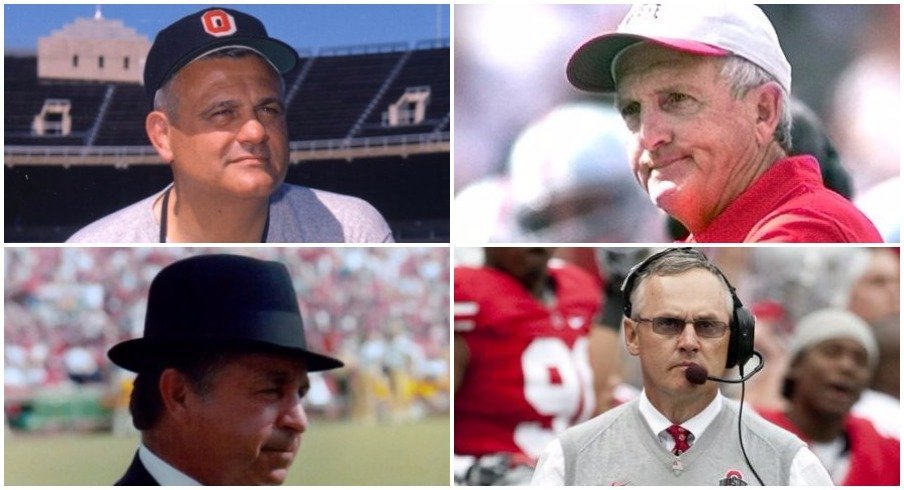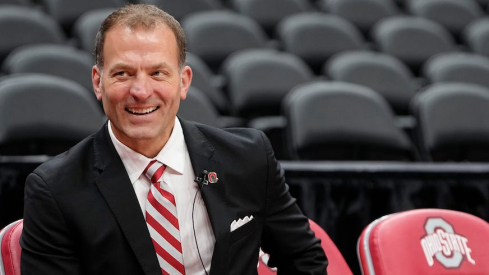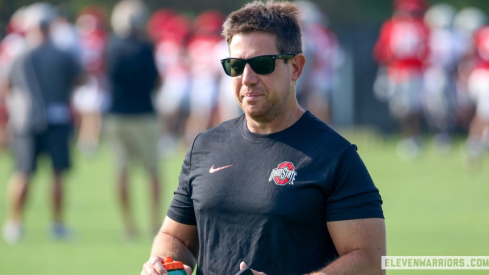I find it a bit hard to believe Urban Meyer is just a little over two months from kicking off his fifth season at the helm of Ohio State's football program.
Time flies when you're largely having fun stomping rivals and collecting trophies, I suppose.
In an effort to put Meyer's heady four-year start in Columbus into perspective, I dove into the first four years of Ohio State's former head coaches since the beginning of the loosely defined modern era – Woody Hayes, Earle Bruce, John Cooper and Jim Tressel – and here's how they stack up against the Ashtabula Assassin.
| COACH | YEARS | WON | LOST | TIE | B1G TITLE | NAT'L TITLE |
|---|---|---|---|---|---|---|
| WOODY HAYES | 1951-1954 | 26 | 9 | 2 | 1 | 1 |
| EARLE BRUCE | 1979-1982 | 38 | 10 | 0 | 2 | 0 |
| JOHN COOPER | 1988-1991 | 27 | 18 | 2 | 0 | 0 |
| JIM TRESSEL | 2000-2004 | 40 | 11 | 0 | 1 | 1 |
| URBAN MEYER | 2012-2015 | 50 | 4 | 0 | 1 | 1 |
WOODY HAYES
Wayne Woodrow Hayes arrived at Ohio State in 1951 toting an assistant coach named Bo Schembechler and a T-formation offense, replacing Wes Fesler's single-wing in which Vic Janowicz excelled en route to the 1950 Heisman Trophy.
Year one was anything but kind as Hayes' squad won only four of nine games (2 ties) to finish 5th in conference. The new offense sputtered to the tune of 12.1 points per game and 47 of the season's 109 points came during a 47-21 win over Iowa at the season's midpoint.
The '51 squad somehow managed to go 2-1-1 over the final four games while scoring just a mere 19 points including zero against Michigan to cap the season.
The following year Woody's troops improved to 6-3 overall and 5-2 in the league, good for 3rd place. Freshman Hopalong Cassidy got the season off the hot start with three touchdowns in the opener against Indiana (33-13) and two weeks later the Buckeyes beat No. 1 ranked Wisconsin, 23-14, in the Shoe for Woody's first signature win.
The offense scored nearly 100 more points in comparison to the '51 outfit capped with a pair of 27-7 wins over Illinois and No. 12 Michigan. Huge underdogs against the Wolverines, the defense forced eight turnovers spoiling a Rose Bowl bid and conference championship for the boys up north.
The 1953 team couldn't use the Michigan game as a springboard again posting an overall mark of 6-3 including 4-3 in conference action. Ranked as high as 7th in the preseason, Ohio State capped an unremarkable season with a 20-point loss to the Wolverines despite entering the game as prohibitive favorites. Woody, now with a 16-9-2 mark over three seasons, heard fans grumbling for a new coach.
Everything changed in 1954, Woody's fourth season in Columbus, as the Buckeyes posted a 10-0 record and captured the national championship. The run came largely out of nowhere with OSU picked to finish 5th in the league by the AP. The squad earned the title beating six ranked teams along the way including No. 2 Wisconson, No. 12 Michigan and No. 17 USC to claim the title.
Woody's 26-9-2 mark over the first four years of his tenure wasn't spectacular but it didn't matter after earning the '54 title, Ohio State's first since 1942.
EARLE BRUCE
The Earle Bruce era sadly began in 1979 after Hayes slugged Charlie Bauman in the Gator Bowl in December 1978 marking the first time in 29 years that the Old Man wasn't on the sidelines.
Bruce arrived via Iowa State and with a roster of Hayes recruits including Art Schlichter, Marcus Marek, Gary Williams, Cal Murray, Doug Donley and Todd Bell, among others, the Buckeyes won the B1G title and just missed a national championship thanks to a 17-16 loss to Charles White and USC in the Rose Bowl.
The unfortunate slip up to USC came on the heels of a spectacular Michigan game in which the Buckeyes won, 18-15, with blocked punt for a touchdown in the closing minutes. Earle's first year in Columbus would be prove to be the best of his Buckeye tenure and certainly the finest of his first four seasons.
Earle's sophomore season started a run of six consecutive 9-3 years. Ranked No. 1 in the preseason polls on the strength of 15 returning starters, the 1980 Buckeyes went 1-3 against ranked teams including back-to-back losses to end the season (No. 10 Michigan, No. 10 Penn State).
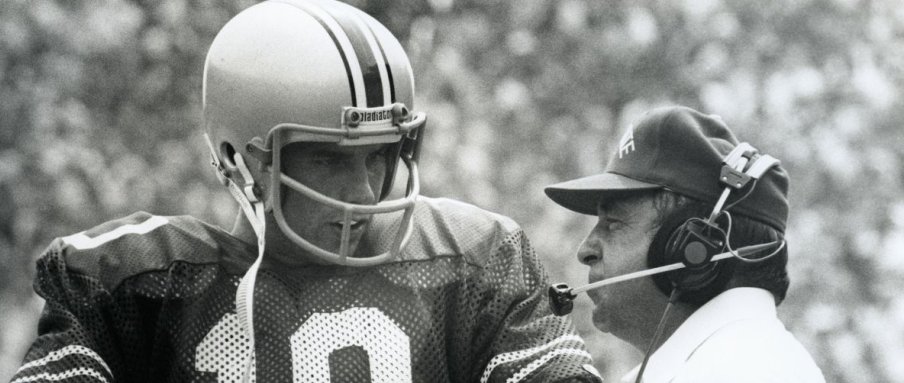
The following year the 9-3 Buckeyes did enough in league play (6-2) to earn a co-championship including a 14-9 win in Ann Arbor. Sadly, the three losses earlier in the season – all to unranked opponents – relegated Ohio State to the Liberty Bowl where they beat Navy, 31-28.
Finally, the 1982 campaign, another 9-3 effort, featured a 7-1 league record good for 2nd place and saw the Buckeyes win seven straight following a three-game losing streak, all of which came in the Shoe.
The final two victories included another over Michigan, 24-14, followed by a 47-17 blowout of Steve Young and BYU in the Holiday Bowl.
Earle's four-year record of 38-10 with two B1G titles was nothing to sneeze at but the three losses per season over the final three years of that run left most fans wanting more.
JOHN COOPER
Following Earle's firing leading up to the 1987 Michigan game, John Cooper arrived in Columbus in 1988 as a relative outsider following head coaching stops at Tulsa and Arizona State.
The '88 team was too white light on talent and it showed during a 4-6-1 campaign featuring a dismal 2-5-1 mark in conference play. The few highlights came early as OSU beat Syracuse in the season opener becoming the first Buckeye outfit in 27 years to commit zero penalties with no turnovers in the same game. Two games later, Cooper beat No. 7 LSU, 36-33, on a wet day in the Shoe coming back from 13 down with four minutes left capped by a Greg Frey to Bobby Olive connection with 30 seconds left in regulation.
The script would be flipped on November 19th with Michigan scoring in the closing minutes to win 34-31 in Ohio Stadium putting the final nail in the season's coffin.
Year two, 1989, saw the Buckeyes improve to 8-4 overall and 6-2 in the B1G (3rd place) but the reality was Ohio State lost to all four ranked teams they played by a combined score of 135-41. Of course, a 28-10 loss to No. 3 Michigan was in that mix along with a 31-14 beatdown at the hands of No. 9 Auburn in the Hall of Fame Bowl.
The 1990 squad continued the quagmire with a 7-4-1 mark featuring a 0-3-1 record against ranked opponents. Yes, Michigan was in that mix beating OSU 16-13 in the Shoe.
The following season, Coop's fourth in Columbus, was more of the same as the Buckeyes finished with an 8-4 mark but once again struggled against ranked teams, going 0-4 including a 31-3 pasting by No. 4 Michigan and a 24-17 loss to No. 16 Syracuse in the Hall of Fame Bowl.
Finishing the four years with a 27-18-2 mark, Cooper was dreadful against ranked teams and went 0-7-1 over the final two games of each season combined. It's still sometimes hard to believe he was given enough time to really start raking in the talent, and wins, starting in '93 and then from '95 - '98.
JIM TRESSEL
James Patrick Tressel burst onto the scene in January 2001 as a darkhorse selection to replace Cooper after the Buckeyes went 8-4 in 2000 capped by an embarrassing 24-7 loss to South Carolina in the Outback Bowl.
Tressel went just 7-5 in his inaugural season but his unranked squad bested an 11th-ranked Michigan team, 26-20, just as he promised, despite the fact the Buckeyes were 11-point 'dogs in Ann Arbor. Jonathan Wells was the star with three touchdowns in the first half.
Of course, the 2001 campaign was merely an appetizer for what The Vest had in store for 2002. Ranked 14th to start the year, the Buckeyes ran through 14 straight opponents, often in dramatic fashion, highlighted by a 14-9 win over No. 12 Michigan and a 31-24 double overtime decision over the historically great Miami Hurricanes to capture the national title. Tressel's squad went 5-0 against ranked teams on the season.
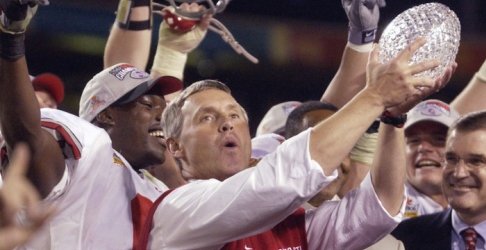
Repeating in 2003 would be an unrealistic task though Tressel did finish 11-2 overall and 6-2 in league play against a tough schedule. Ohio State played eight ranked teams, winning six, including decisions over No. 9 Iowa, No. 14 Michigan State, No. 11 Purdue and No. 8 Kansas State in the Fiesta Bowl.
The 2004 season served as a temporary lull for Tressel's program with a rare three-game losing streak in October triggering an 8-4 season that still saw the Buckeyes beat Michigan and win their bowl game, this time a 33-7 victory over Oklahoma State in the Alamo Bowl.
Rolled up, Tressel went an impressive 40-11 with a B1G title and a national championship during the four-year span.
URBAN MEYER
You're already intimately familiar with Meyer's dominance over his first four years so I'll spare you a litany of words and focus on the highlights.
Arriving on the heels of a 6-7 season following the Tatgate fiasco, Meyer engineered a perfect 12-0 mark in his first season featuring smoke, mirrors and sleight of hand. Self-imposed sanctions kept the Buckeyes out of the B1G title game and the bowl season but Meyer's immediate impact could not be ignored.
The following season saw Ohio State peel off 12 straight wins before faltering late, losing to No. 10 Michigan State in the B1G championship and to No. 12 Clemson in the Orange Bowl.
Meyer's finest work to date came in 2014 as he not only rode redshirt freshman quarterback J.T. Barrett to 11 wins in the first 12 games but also partnered with Tom Herman to get third-stringer Cardale Jones ready to roll through Wisconsin the B1G championship and then Alabama and Oregon in the College Football Playoff to capture the crystal.
With so many returning stars from the 2014 squad, the reality is 2015 turned out to be a disappointment which considering Ohio State went 12-1 with routs of both No. 12 Michigan and No. 8 Notre Dame to cap the season tells you all you need to know about Meyer's program.
Over his first four years, Meyer has 50 wins against just four defeats with a B1G title and a national championship.
Mark me down with being good with Four More Years!
